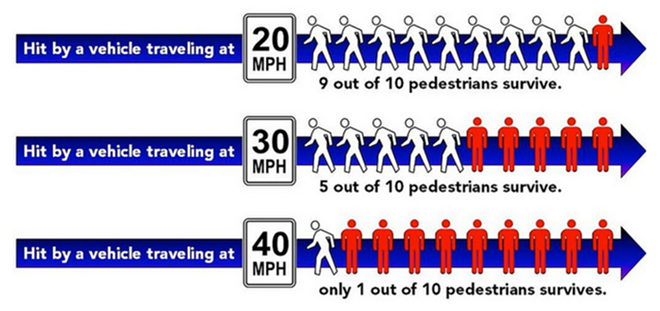
Crossing the street can be a pretty dicey endeavor in Tampa.
That's why, in the wake of the death of a teenage girl who was struck while trying to cross Bruce B. Downs Boulevard, Tampa City Councilwoman Lisa Montelione asked the city to step up its efforts to fight pedestrian fatalities. On Thursday, Council agreed to pursue Vision Zero, an effort to tackle the phenomenon multiple cities have undergone — and with measurable success — in recent years.
“[Pedestrian] death is not an accident, it's preventable," Rudy Umbs, chief highway safety engineer with the Federal Highway Administration, told the Council. "Human life takes priority. It's important that human life counts.”
So far this year, a pedestrian or bicyclist has died as a result of an auto crash, on average, more than once a week. Countywide, there have been around 20 more of these kinds of deaths in the first 11 months of 2015 than there were last year, when there were 34, and officials are concerned a busy month may see a spike before the year is through.
“As of now, we're at 53,” said Tampa Police Lt. Richard Mills. “Unfortunately December is the holiday season, so there's going to be a lot more people in the Tampa Bay area.”
Various studies have ranked Tampa close to the top in terms of such fatalities, which could be due in part to the weather as well as how the city was planned decades ago, Montelione said.
“The reasons for our city and our state having a high number of fatalities is, one, the weather because more people are out on the roads biking and walking more days of the year than other places, and that our roads were engineered to get people as fast as possible through the roadways to their destination,” she said.
The Vision Zero plan is likely to entail a multifaceted effort to tackle the problem, encompassing everything from discouraging distracted driving to lowering speed limits in problem areas, which could help make pedestrian strikes less deadly, if not preventing them entirely, by allowing drivers more reaction time if someone walks out in front of their car. Red light cameras, which are in place and already controversial, may be used to slow drivers down as well.
“It's a matter of people working together from all areas,” Umbs said.
But education — especially on the distracted walking and driving front — can't be ignored, said Councilman Harry Cohen.
“People have got to wake up, they've got to pay attention, they've got to stop texting and talking and combing their hair when they are driving," he said. "They need to look when they're crossing the street, and they need to start paying attention.”
The decrease in pedestrian deaths other cities that have implemented Vision Zero, while none have dropped to zero, has been significant.
In Sweden, Germany, France & Spain, there has been a 30 to 50 percent decrease in deaths, Umbs said. In Minnesota, Utah and Washington, the numbers have gone down by 43, 48 and 40 percent, respectively.
In Tampa, the nonprofit Walk Bike Tampa — launched by Tampa mothers Hanna Strom and Jackie Toledo (the same Jackie Toledo who ran for Council earlier this year) — would lead the Vision Zero effort.
“Our vision is that any person at any address in Tampa, any age, any ability, can safely, safely walk from one address to another or bicycle,” said Christina Costa, a spokeswoman for the group. “One death on our roadways is one death too many, and it's unacceptable.”
She said it's a tall order for the city to attract educated millennials without making the city safe and easy to get around without a car.
“Tampa can't be this great city where we're number ten for bicycle-friendly businesses and also the city that rates too poorly for walking and biking safety," Coast said. "Those are two opposed Tampas. So we want to be in the Tampa that actively protects the most vulnerable of our citizens.”

